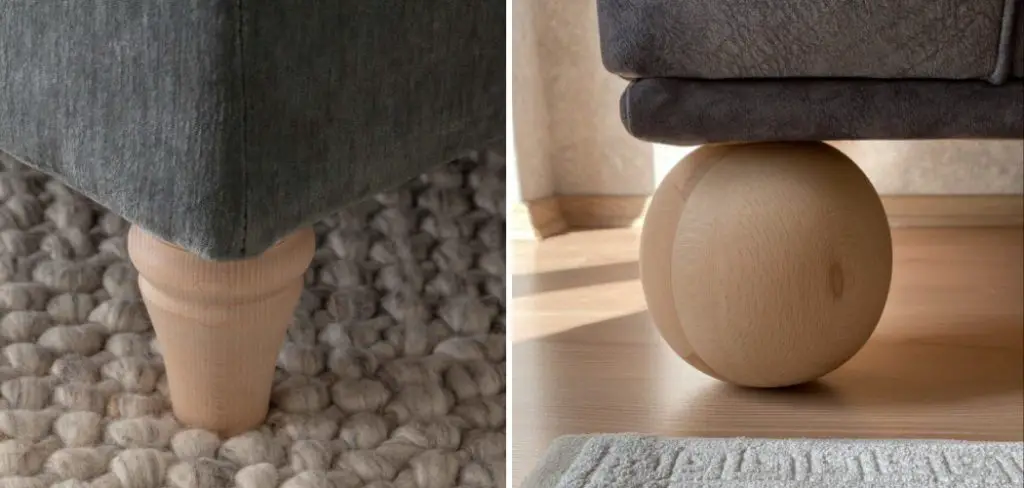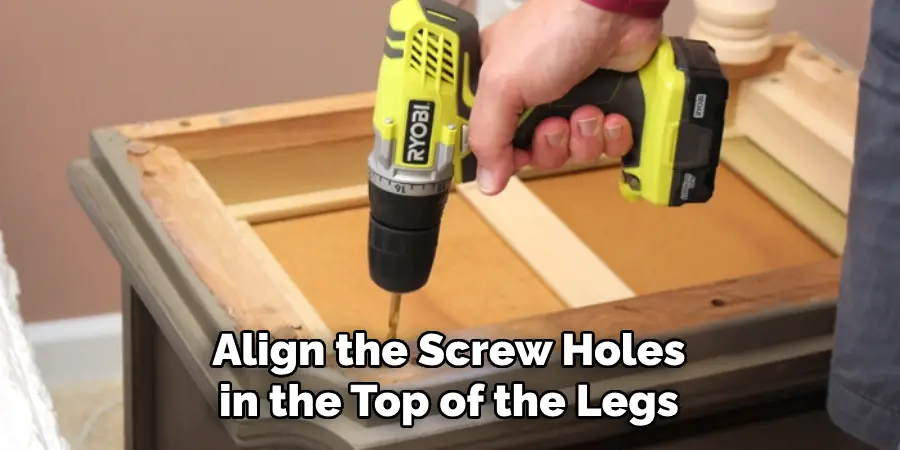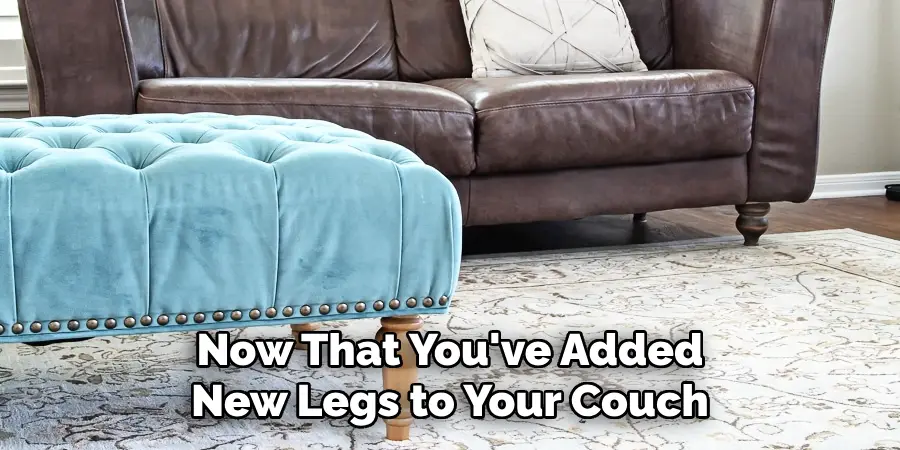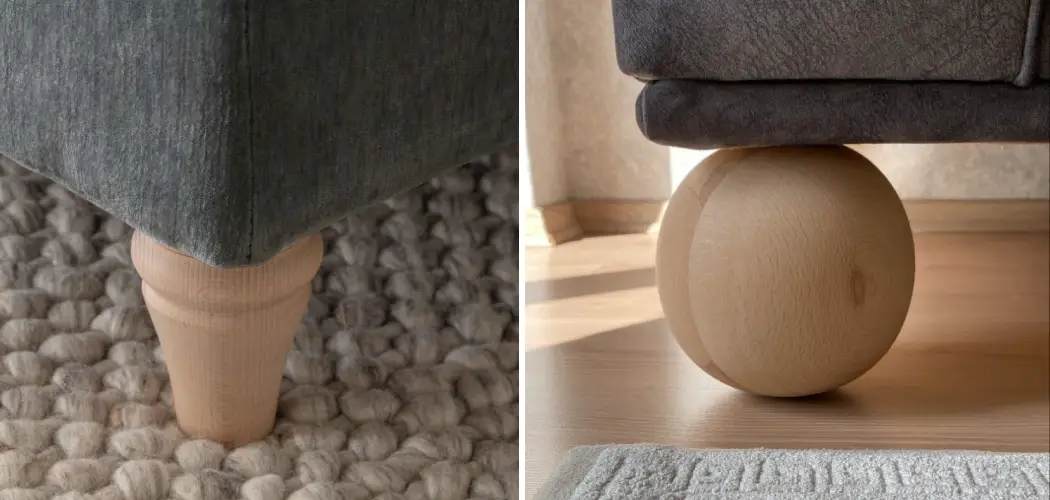If you’re like many people, you may have been struggling to figure out how to attach legs to a couch with no pre-drilled holes. Have no fear: this task may seem daunting, but with effort and the right equipment, you can add those new stylish legs within minutes.

This blog post will give you step-by-step instructions so that even if it’s your first time tackling this project, don’t worry — we’ll walk through everything about how to put legs on a couch with no holes!
So whether you want larger or smaller legs on your couch for a more custom look or just need an easy fix so your furniture won’t wobble anymore, let’s get started and find the perfect way to fit those lovely new legs onto your beloved sofa!
What Will You Need?
Before we get into the process, let’s make sure you have all the necessary materials on hand. Here’s what you’ll need:
- Couch with no pre-drilled holes for legs
- Legs of your choice (make sure they are the right size and style for your couch)
- T-nuts or hanger bolts (these will act as the connection between the legs and the couch)
- Drill
- Measuring tape
- Pencil or marker
- Screws (if using hanger bolts)
Once you have all these materials ready, we can move on to the next step.
10 Easy Steps on How to Put Legs on a Couch With No Holes
Step 1: Measure and Mark
The first thing you need to do is measure and mark where you want your legs to be placed. Using a measuring tape, find the center of each side of the couch (front, back, left, right) and mark it with a pencil or marker. If your couch is rectangular, this will be a simple process. If it has an unusual shape, you may need to measure and mark more than four points.

Once you have marked the center of each side, use the measuring tape again to find the distance between the center point and the edge of the couch. This measurement will help you determine where to place your legs.
Step 2: Preparing for Drilling
After marking the spots, you need to prepare for the drilling process. Begin by choosing the right size drill bit. The drill bit should match the screw size on your T-nuts or hanger bolts. Now, place the point of the drill bit on the mark you created. Ensure you’re holding the drill perpendicular to the couch to avoid any angled holes.
Take a deep breath and start drilling slowly. It’s important to go slowly and steadily, applying consistent pressure, but not so much as to split the material. Drill until you’ve created a hole deep enough to accommodate the entirety of the T-nut or hanger bolt.
Step 3: Installing the T-Nuts or Hanger Bolts
Once your holes are drilled, it’s time to install your T-nuts or hanger bolts. If you’re using T-nuts, place them in the holes and hammer them carefully into place until they’re flush with the surface of the couch frame. The prongs of the T-nuts should dig into the material, helping to keep them firmly in place. For hanger bolts,
simply screw them into the holes you drilled. Ensure they’re screwed in straight and tight, but be careful not to over-tighten, as this could damage the couch frame. Once your T-nuts or hanger bolts are installed, you can attach the legs.
Step 4: Attaching the Legs
Now that the T-nuts or hanger bolts are securely in place, it’s time to attach your new couch legs. Align the screw holes in the top of the legs with the T-nuts or hanger bolts on your couch. Once aligned, begin to screw the legs into place.

Again, ensure you’re not over-tightening to avoid any damage to the couch frame or the legs. Continue to screw the legs on until they’re firmly attached and do not wobble when you shake them lightly. Congratulations! Your couch now has a new set of legs.
Step 5: Final Check and Adjustments
With the legs now attached, stand the couch upright and ensure it sits level on the floor. If you notice any wobbling, check each leg to ensure they’re securely attached. If the couch still doesn’t sit level, it may be necessary to adjust the legs slightly. Some couch legs have built-in adjustable feet that you can tweak until the couch sits level.
If your legs don’t have this feature, consider adding felt pads or furniture sliders to the legs. These can help compensate for any unevenness in the floor and prevent scratches. Finally, take a step back and admire your work. You’ve successfully added legs to a couch that had no pre-drilled holes!
Step 6: Maintenance and Care
Now that you have successfully attached the legs to your couch, it’s important to ensure they remain secure and sturdy over time. Regularly check the legs for any signs of loosening, and tighten them as needed. If you find that a leg is persistently loose,
it may be worth applying a small amount of wood glue to the screw hole before reattaching the leg – this can help to provide additional stability. Remember, a well-maintained couch not only looks better, but it also ensures a longer lifespan for your furniture. Congratulations on your newly updated custom couch!

Step 7: Enjoy Your Refreshed Couch
Now that you’ve successfully added new legs to your couch, it’s time to enjoy the fruits of your labor. With its refreshed look and elevated height, your couch will not only be more comfortable but also a proud testament to your DIY prowess. Whether it’s to enjoy a cup of coffee, indulge in your favorite book, or to host friends and family, your updated couch is ready for anything.
Remember, the key to a successful DIY project is patience, precise measurements, and the confidence to take on the challenge. Congratulations once again on your successful project, and we can’t wait to see what you tackle next!
Step 8: Share Your Success
Now that you’ve added new legs to your couch, why not share your success? Take a before-and-after photo of your couch and post it to your favorite social media platforms. Remember to use hashtags related to DIY and furniture refurbishment to connect with others who share your interests.
By sharing your experience, you inspire others to take on similar DIY projects. Plus, it’s always nice to receive compliments on your hard work. So, go ahead and show off your refreshed couch. You’ve worked hard, and you deserve the recognition!

By following these steps, you should now have a better understanding of how to put legs on a couch with no holes.
5 Additional Tips and Tricks
- Gather the Right Tools: Before you start, make sure you have the right tools for the job. A drill, a set of screwdrivers, and some screws are typically necessary. If you’re unsure about the type of screws to use, consult with a hardware store.
- Plan the Placement: Measure and mark where you want to place your couch legs. Think about the balance and stability of your couch when marking these spots.
- Pre-drill the Holes: To make the job easier and to prevent damaging your couch, pre-drill the holes where you will be attaching the legs.
- Attach the Legs: Align the top of the leg with your pre-drilled hole and attach it using the screws. Make sure it is tightly secured.
- Check Stability: Once all legs have been attached, carefully put your couch upright and check its stability. If the couch wobbles, you may need to adjust the legs or add additional support.
With these tips in mind, you should be able to attach legs to your couch with no holes successfully.
5 Things You Should Avoid
- Avoid Rushing: Patience is key. Ensure you take time to measure, drill, and attach the legs. Hasty work could lead to inaccurately placed legs or even damage to your couch.
- Don’t Use Inappropriate Tools: Using tools unsuitable for the job can cause damage. For example, using a hammer instead of a drill to create holes could destroy the couch’s structure. Always use the appropriate tools.
- Avoid Poor Quality Legs: Resist the temptation to save money by purchasing cheap, low-quality legs. They may not provide the desired stability and can break easily, causing potential damage and safety risks.
- Don’t Ignore Wobbling: If your couch is wobbling after attaching the legs, it’s a sign that something is wrong. Pay attention to this as it could lead to collapse. Recheck your measurements and adjust the legs as needed.
- Avoid Neglecting Maintenance: Once the legs are attached, they may loosen over time. Regularly check and tighten the screws to keep the couch stable and secure.
By avoiding these common mistakes, you can ensure a successful and safe outcome when putting your legs on a couch with no holes.
Understanding the Importance of Proper Leg Placement
Proper leg placement is crucial for the stability and longevity of your couch. Placing them too close to the edge can cause tipping, while placing them too far, it may result in an unstable couch. Additionally, evenly distributing the weight on each leg is essential to prevent sagging or collapsing over time.
Another factor to consider is the type and shape of your chosen legs. Tapered or angled legs provide more stability than straight, cylindrical ones. Also, make sure the legs are securely attached to the frame of the couch for maximum support.

Proper leg placement not only ensures safety and durability but also enhances the overall aesthetic of your couch. So, take your time and carefully plan out where and how you will attach the legs to achieve a functional and visually appealing piece of furniture.
How Do I Choose Couch Legs?
When it comes to choosing couch legs, there are a few factors to consider.
- Material: Couch legs come in various materials, such as wood, metal, or plastic. Each has its own pros and cons, so choose one that best suits your needs.
- Style: Consider the overall style of your couch when choosing legs. For a modern look, consider metal or tapered wooden legs, while for a more traditional look, choose rounded or carved wooden legs.
- Height: The height of the legs can affect the overall appearance and functionality of your couch. Higher legs can create a more open and airy feel, while lower ones add a more grounded look.
- Weight Capacity: Make sure to choose legs that can support the weight of your couch and its occupants. Check the weight capacity listed on the legs to ensure they suit your needs.
By considering these factors, you can choose the perfect legs for your couch that not only provide stability but also complement its design.
Conclusion
Overall, building a couch with no holes is quite a challenge. But if you’re up for it, use the techniques shared above to make your vision a reality. You’ll need to have patience and take extra measures to ensure safety at all times, but successfully constructing your custom couch will be immensely satisfying!
Hopefully, these tips and tricks have helped you understand how to put legs on a couch with no holes. Remember to consistently gather the necessary tools, plan out your placement, and carefully attach the legs for optimal stability.
Now that you understand the tools and materials needed for this project, it’s time to start putting together your own piece of furniture art! Go ahead, show off your skills as a handyman (or woman) – let there be legs on that couch!

